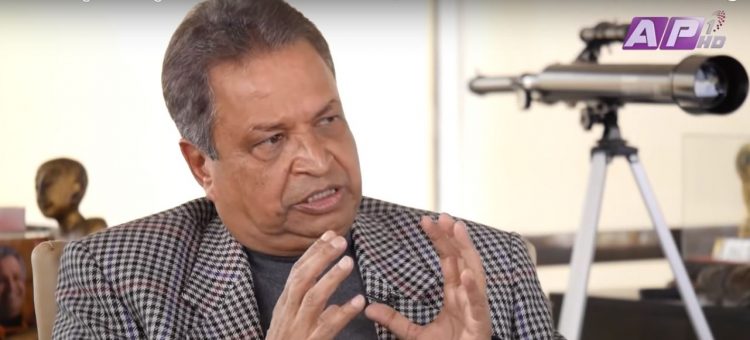Binod Chaudhary wrongly claims internet in Nepal is South Asia’s priciest
Sanjog Shiwakoti / February 24, 2020

Binod Chaudhary, president of Chaudhary Group. Photo: Youtube grab
Binod Chaudhary, the president of Chaudhary Group, one of the largest business groups of Nepal, appeared on a talk show ‘Tamasoma Jyotirgamaya’ aired on AP1 HD Television on February 3. While answering to the questions from the show’s host, Tikaram Yatri, for over an hour, Chaudhary said the following about Nepal’s telecommunications sector:
“The internet price in Nepal is currently the most expensive in South Asia. Internet penetration here is just 35 percent because it is so expensive.”
Here he made two claims:
First claim: The internet price in Nepal is currently the most expensive in South Asia.
Second claim: Internet penetration in Nepal is just 35 percent. [In other words, just 35 percent of Nepal’s population has access to the internet]
South Asia Check has examined Chaudhary’s claims one by one.
First claim: The internet price in Nepal is currently the most expensive in South Asia.
According to cable.co.uk, a UK-based website that compares internet prices worldwide, broadband internet in the Maldives is the most expensive in South Asia. The average monthly price of broadband internet in the Maldives is US $88.53. The prices of average monthly broadband in the other countries in South Asia are as follows: Sri Lanka ($27.4), Bangladesh ($27.35), Afghanistan ($25.87), Pakistan ($17.55), India ($12.9), Nepal ($12.05) and Bhutan ($10.42). The figures show that Bhutan offers the cheapest internet among the seven countries of South Asia followed by Nepal. Click here for worldwide internet prices.
Nepal is among the five countries that provide world’s cheapest internet packages. Nepal provides its cheapest package for US$ 0.87, according to the website. However, the speed of the cheapest broadband package is relatively slow and availability is limited, according to the British website.
This shows Chaudhary’s first claim is false.
Second Claim: The penetration of internet in Nepal is just 35%.
Nepal Telecommunications Authority’s annual report of the fiscal year 2074/75 [2017/18 AD] states, “There has been a desirable progress on internet penetration. As a result, the density has reached 51% with the internet subscriber numbers reaching around 15 million.”
Similarly, according to the Management Information System (MIS) report of Kartik 2076 (September 18-October 16, 2019), published by Nepal Telecommunications Authority, “internet density” has reached 71.52% with total 21.11 million internet subscribers.
Therefore, Chaudhary’s second claim is also false.
This material is copyrighted but may be used for any purpose by giving due credit to southasiacheck.org.
Comments
Latest Stories
- In Public Interest Covid-19 cases are low, but that’s not an excuse to avoid vaccination
- In Public Interest What is BF.7, the sub-variant that has the world by its grip?
- In Public Interest Threat of a new Covid-19 wave looms large amid vaccine shortage in Nepal
- In Public Interest As cases decline, Covid-19 test centres in Kathmandu are desolate lot
- In Public Interest Dengue test fee disparity has patients wondering if they’re being cheated
- In Public Interest As dengue rages on, confusion galore about what it is and what its symptoms are. Here’s what you need to know
In Public Interest
 Covid-19 cases are low, but that’s not an excuse to avoid vaccination
The Pfizer-BioNTech bivalent vaccines authorised by the Nepal Government provide better protection a...
Read More
Covid-19 cases are low, but that’s not an excuse to avoid vaccination
The Pfizer-BioNTech bivalent vaccines authorised by the Nepal Government provide better protection a...
Read More
- What is BF.7, the sub-variant that has the world by its grip?
- Threat of a new Covid-19 wave looms large amid vaccine shortage in Nepal
- As cases decline, Covid-19 test centres in Kathmandu are desolate lot
- Dengue test fee disparity has patients wondering if they’re being cheated
- As dengue rages on, confusion galore about what it is and what its symptoms are. Here’s what you need to know